PinotFile: 7.25 September 5, 2009
|
Heart & Hands: Passion for Pinot in the Finger LakesTom Higgins grew up in the Finger Lakes region of New York. While still in high school, he worked at Hazlitt 1852 Vineyards learning both winemaking and tasting room management. He studied accounting and information systems in college, thinking that the technology field was a great way to make a quick buck and allow him to eventually have his own winery. He entered the technology industry during the dot-com boom of the 1990s, and met his future spouse, Susan, who was also a wine lover, while they were both on corporate assignment in Ohio. Tom quickly longed to return to the wine industry and told me, “The tech industry was interesting for a while, but there were just too many 3:00 A.M. ‘emergency’ pages among other irritating things.” He left his job and started working for Zachy’s Wine & Liquor in Scarsdale, New York. This was an eye-opening education into the world of wine. The connections he made at Zachy’s enabled him to work in Bordeaux at Chateau La Lagune and learn old world winemaking techniques. Unfortunately, at the time, Domaine Romanee-Conti already had an intern and Domaine Dujac felt like they had helped enough young American winemakers with their success.
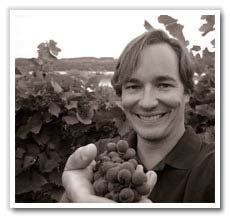 Upon his return to the states, Tom worked a harvest at Calera Wine Company in California. He then ventured back to the Finger Lakes, working for Thirsty Owl Wine Company and Atwater Estate Vineyards, while preparing to launch his own winery, Heart & Hands Wine Company. I met Tom at Thirsty Owl Wine Company during a trip I made to the Finger Lakes a few years ago. His spouse, Susan spent many vacation weekends in the Finger Lakes and after obtaining an MBA from New York University Stern School of Business, the couple were married and Susan works for a leading management consultant firm when not assisting Tom with winemaking activities. A suitable site for a vineyard and winery was chosen on a gently sloping hillside overlooking the eastern shore of Cayuga Lake. The site is ideal for Pinot Noir and Riesling, with soils redolent of Onondaga Limestone with outcroppings of shale. The proximity to the lake and the gently sloping site offer the future vineyard protection from harsh winter weather. In 2008, winery construction was completed and a tasting room opened the following year. As the 6-acre estate vineyard is developed, Heart & Hands has obtained acreage contracts with several premier winegrowers including Sawmill Creek Vineyard and Hobbit Hollow Farm. Current production is under 800 cases of Pinot Noir, Brut Rosé and Riesling. The Claddagh ring on the label is the traditional Irish wedding ring symbolizing friendship and togetherness (the hands), love (the heart), and loyalty and fidelity (the crown). It is worn by people of Irish descent the world over as a source of pride in their heritage. At Hearts & Hands, the Claddagh symbolizes the Higgins’ passion for wine and loyalty to their customers.

The Finger Lakes region is a challenging area for successfully growing vitis vinifera. The winters are cold, vine diseases are always a threat, and ripening can be an issue. In a Wine Spectator article published in 2006 on New York wine country, there was a comment about Pinot Noir that read, “The jury is out on Pinot Noir; some winemakers love the challenge it poses in a tricky climate and have had decent results, while others say it's too much of pain to grow.” This is similar to the same refrain about the heartbreak grape heard in California and Oregon 40 years ago. Many Finger Lakes wineries have turned to newer hybrid grapes, such as Corot Noir, Valvin Muscat, Cayuga White, Noriet and Traminette, which are adaptable to the region, yet have different flavor profiles than wines made from vinifera grapes. Many proponents of the region are opposed to hybrid varieties. Hermann J. Weiner came to the Finger Lakes region in the early 1970s to work at Bully Hill Winery on Keuka Lake. He was fired for developing an experimental nursery of vinifera vines. He later would become famous for producing the first dry Riesling in the United States. Another Finger Lakes vinifera advocate was Dr. Konstantin Frank. He was able to successfully cultivate vinifera vines by choosing proper rootstocks planted in sites close to the lake allowing the vinifera vines to survive the sub zero winters of the Finger Lakes region. Frank's original 9-acre Pinot Noir vineyard is planted to the Dr. Frank clone obtained from Europe. The oldest blocks were planted from 1959 to 1961 making them as old as most early California plantings of Pinot Noir still in production except the 1953 block at Hanzell. The Finger Lakes region produces almost every common vinifera varietal but Riesling has clearly been the star here with sparkling wines showing great potential. The small number of Pinot Noirs produced have been more akin to Burgundy than to Oregon or California. The acids are typically high and the alcohols are low (around 12%). The wines are lighter in color with restrained and subtle flavors. One must approach the Pinot Noirs with an open mind and a vinous curiosity, since they are unique expressions of the Finger Lakes region.
Tom is very forward thinking about his wines and winery. He has been using the glass Vino-Seal closure on some of his wines, This seal has a number of advantages. It eliminates cork taint, it is “cooler” than a screw cap, easy to apply, easy to reseal the bottle with, and 100% recyclable. The downside is the risk of reduction, so Tom focuses on sulfur levels at bottling, keeping them around 50% of what he would be used under cork. The Heart & Hands tasting room allows a special tasting experience for $10 that is uniquely different from most wineries in the area. Tom and Susan take guests into the cellar and taste Pinot Noir from barrels, offering an educational session on barrels, whole cluster, and site differences in determining the character of finished wines. Heart & Hands Crush Camp offers seven participants the chance to work harvest at the winery while enjoying accommodations at the nearby E.B. Morgan House in Aurora, New York. Activities include picking grapes, sorting grapes, daily punch downs, lab analysis, pressing grapes, and of course, plenty of cleaning. Participants also receive six bottles of wine from the harvest and plenty of swag.
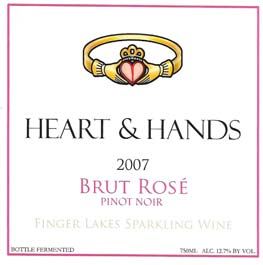 2007 Heart & Hands Finger Lakes Brut Rosé 12.7% alc., pH 3.18, 32 cases. 100% Pinot Noir grown on Seneca Lake vineyards. Grapes were fermented 23 hours on the skins. Whole clusters were then gently pressed with a basket press and transferred to stainless steel for a 16-day fermentation. Secondary fermentation was induced in the bottle and the wine was disgorged January 20, 2009. · Pale rose color. Scents of strawberries, red roses and a hint of yellow peach. Clean and crisp flavors of fresh berries, persimmon and a faint herbal note. A perfect summer wine.
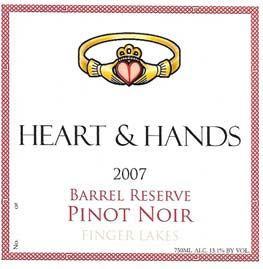 2007 Heart & Hands Finger Lakes Barrel Reserve Pinot Noir 13.1% alc., pH 3.63, 146 cases, $40, both cork and Vino-Seal closures. Unusually warm and dry growing season causing more of a West Coast influence on the wine. Twenty-three 90+ degree days which thickened skins for more color and flavor extraction. 75% clone 115 and 25% clone 777 cropped at 1.7 tons per acre. 100% whole cluster. 11-day fermentation, basket pressed, and aged for 18 months in 66% new and 33% once-used Francois Freres French oak barrels. · Brooding nose initially that opened with swirling to reveal dark fruits, especially black raspberry, a hint of spice, smoke and incense. Held up beautifully in the glass over time. On the attack, the wine was full-bodied with a substantial tannic backbone. Plentiful dark fruits were complimented by an earthy underpinning and a faint note of grapefruit peel on the finish. Silky and beautifully composed, but still needing time for the tannins to soften and integrate. Amazing fruit intensity but not jammy, with the acidity holding forth to reign in the hedonistic fruit and tannins. Would recommend decanting now or cellaring for a couple of years. A very, very impressive wine like nothing I had ever previously tasted from the Finger Lakes region. Given the proper weather, viticulture management, and in the hands of a talented winemaker, the potential for premium Finger Lakes Pinot Noir is exemplified here.
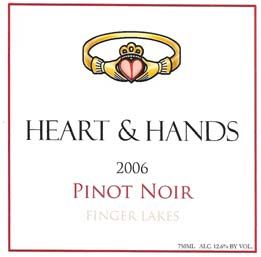 2006 Heart & Hands Finger Lakes Pinot Noir 12.6% alc., pH 3.52, 232 cases, $20, Vino-Seal. September marked by rain prolonging harvest. Clone 115 cropped at 2 tons per acre. 50% whole cluster with manual punch downs twice daily. 13-day fermentation without cold soak or extended maceration. Basket press used for extraction. Aged in 40% new and 60% once-used Francois Freres oak barrels. · Lovely aromatics initially featuring strawberries, cherries, red licorice and nutmeg. With time in the glass, notes of raisins and marzipan emerged. The palate was quite charming initially with red fruits, sassafras, spice, and mocha and was silky smooth with bright acidity and reigned-in tannins. Over time the fruit intensity faded with acidity coming to the forefront, and I was looking for some food to compliment the wine.
Heart & Hands Wine Company is located at 4162 State Route 90N, Union Springs, New York. The tasting room is open on weekends from 12:00 to 5:00 and weekdays by appointment. The wines are available online at www.heartandhandswine.com. For further information, consult this video and winery review by Jason Feulner, Finger Lakes Correspondent: http://lennthompson.typepad.com/lenndevours/2009/07/
Bennett Valley: The Secret is OutBennett Valley only consists of about 700 planted acres, but the wines from this tiny appellation are making an impression on wine aficionados. Matanzas Creek Winery, which released a 2007 Bennett Valley Pinot in the 2007 vintage, its first since the 1970s, is the most high-profile producer in this region. Bennett Valley is Sonoma County’s newest appellation, awarded approval in December 29, 2003. Located 45 miles northeast of San Francisco, the appellation is surrounded by three mountains: Taylor Mountain to the West, Bennett Peak to the East and Sonoma Mountain to the South (see map on the next page). The soils are mainly rocky and volcanic in origin. Most vineyards are planted between 500 and 600 feet elevation and enjoy a consistent marine influence throughout the growing season. The Crane Canyon/Grange Road gap in the mountains allows cooling fog and wind to enter the valley moderating summer temperatures and creating conditions that are ideal for cool climate grape varieties. There are 8,140 total acres in the appellation occupied by 36 growers and 4 wineries (2004 statistics). According to the Bennett Valley Grape Growers, only 9% of the planted acreage is Pinot Noir, with Merlot and Chardonnay making up over 66% of the total. A complete history of Bennett Valley is available on the Bennett Valley Grape Growers website (www.bvgg.org). Grey Stack Cellars was formerly known as Dry Stack Cellars, but the owners of Dry Stack Sherry felt the name was confusing. The name was changed to Grey Stack, which refers to a dry stack rock wall made from gray basalt native to Bennett Valley. Grey Stack Cellars sources fruit primarily from two estate vineyards (Dry Stack Vineyard at the home ranch in Bennett Valley and Greywacke Vineyard, located in the Russian River Valley). Pinot Noir fruit is sourced from the Connell Family Vineyard in Bennett Valley. The owners of Grey Stack Cellars are Peter and Marie Young who came to Sonoma County in 1999. Their first commercial wine, a Syrah from Dry Stack Vineyard, was produced in 2005. Russell Bevan of Bevan Cellars in Bennett Valley was the winemaker until 2009, when he was replaced by Pat Sullivan (Rudd Winery, Peter Michael, Lewis Cellars and Paul Hobbs) and assistant winemaker Randall Watkins. Although Grey Stack Cellars has focused on Syrah, Grenache, a Syrah-Grenache blend and Sauvignon Blanc from estate grapes, the winery plans to expand Pinot Noir and Grenache offerings and add Chardonnay to the lineup over the next few years. I recently sampled the latest Pinot Noir offering from Grey Stack Cellars and was very impressed. The Connell Family Vineyard is just up the road from the Grey Stack home ranch. The vineyard manager is Chris Bowland. This wine serves notice that the Bennett Valley is an untapped promising region for Pinot Noir.
 2007 Grey Stack Cellars The Fisherman Connell Family Vineyard Bennett Valley Pinot Noir 14.5% alc., pH 3.85, 50 cases, $35, to be released soon. This wine is named for Peter Young’s father who is an avid fly fisher and Pinot Noir lover. Clones are 115 and Pommard. 5- day cold soak, aged 12 months in French oak. · Moderately dark reddish-purple color. Attractive aromas of dark fruits, Provencal herbs and seasoned oak that pick up intensity with time in the glass. Very tasty fullbodied flavors of plums and black raspberries with a subtle underpinning of oak. Mouth coating fruit with a smooth, creamy texture that speaks of pinotosity, and noteworthy persistence on the pleasing finish. Everything is working in harmony. This is a wine that is definitely worth seeking out, especially given the sensible price.
Grey Stack Cellars wines are available on the website at www.greystackcellars.com, and through the winery’s mailing list. For tours of the estate vineyards or tasting, phone the offices of Grey Stack Cellars in Santa Rosa at 707-228-1338.
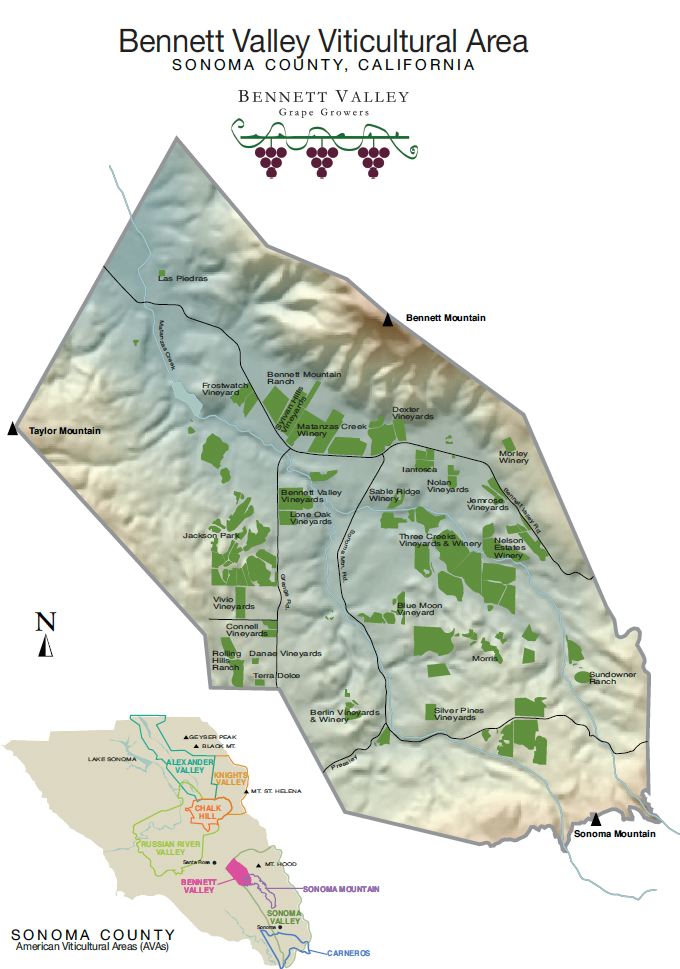
Alana Estate: New Star Arrives in the U.S.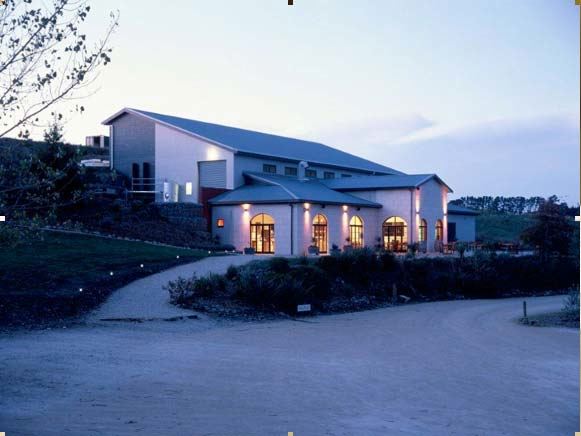 Alana Estate is not a familiar name to American Pinot Noir geeks, but this estate will shortly be exporting their excellent Pinot Noir to the United States, and I am confident this wine will find a place in many of their cellars. Alana Estate was established in 1992 by a group of shareholders headed by Ian and Alana Smart. Encompassing 55 acres of land, 42 acres of which are in planted vines, and located on the northern edge of the Martinborough Terrace, this estate is believed to be the driest location in Martinborough. The site is cool with well-drained deep stony soil making growing conditions ideal for Pinot Noir, Chardonnay, Riesling and Sauvignon Blanc. Recent plantings are dominated by close density and low trellised Pinot Noir. The vineyard will be in full production in 2010. Alana’s most immediate neighbor is the world-renowned Dry River, which occupies 30 acres of land immediately adjacent the Alana Estate. Ata Rangi and Martinborough Vineyards are close by.
Martinborough’s alluvial river terraces of deep, free-draining gravel overlaid with gravely silt loam are ideal for growing Pinot Noir. The climate is conducive as well, with low rainfall, warm dry summers, and a long, reliably dry autumn. The weather can be unpredictable, however, with a significant threat of frost and bad weather always looming early in the growing season. The cool evenings during the growing season allow the grapes to retain acidity, although acid is often added during winemaking. Combined with low yields and a focus on quality, the Martinborough region has received international recognition for producing top quality Pinot Noir as well as Chardonnay, Riesling and Sauvignon Blanc. The first vineyards were planted in Martinborough in 1978 by Alistair Taylor at about the same time that a report by Derek Milne was published which identified the stony terraces around town as ideal for viticulture. By the early 1980s, the area had five mainstay wineries which included Ata Rangi, Te Kairanga, Chifney, Dry River and Martinborough Vineyard. The second wave arrived in late 1980s including Palliser Estate, and the third wave in the 1990s with the arrival of Escarpment and the Craggy Range Vineyards at Te Muna as well as Alana Estate. The Alana Estate is home to a modern gravity-flow winery which is set up to allow multiple small batches of wine to be processed. In 2008, 8,200 cases of wine were produced and the 2009 harvest was even better, producing 11,000 cases.
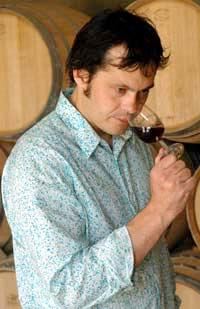 Winemaker Chris “Hopper” Archer is an Aussie who claims, “ I was forced into the wine industry by parents at the tender age of seventeen, who were hoping to have an endless supply of good wine for their retirement. Their plans came into fruition, except that I eventually escaped to New Zealand to attempt to rebuild my depleted cellar.” Archer’s first job was with Tyrrell’s Wines in Hunter Valley and while completing his winemaking degree, continued vintage work for Tyrrell’s at Wolf Blass in Clare and Rosemount in McLaren Vale. After obtaining his wine science degree, Archer returned to Tyrrell’s in 1992 as assistant winemaker and was put in sole charge of the company’s Pinot Noir program. After a subsequent highly successful five year stint at a small boutique winery, Pepper Tree Wines, he was coerced to New Zealand in 2000 by Morton Estate, before eventually joining Alana Estate. Along the way, Archer has collected a slew of trophies for his wines. Recently, I was contacted by Flinn Flexer, an American living in Sherman Oaks, California, who has become a shareholder at Alana Estate and is the United States importer of Alana Estate wines beginning in 2009. He estimates that 2,500 cases of the 2008 Alana Estate Pinot Noir will be exported to the United States. I tasted the 2008 Alana Estate Pinot Noir with Flinn and later at home in private and my notes were consistent. The label below is preliminary.
2018 Albatross Ridge Estate Carmel Valley Monterey Chardonnay 13.0% alc., pH 3.23, 450 cases, $68. Clones 96 and 15 harvested at 1.53 tons per acre and a harvest Brix of 20.0º-23.5º. · Moderate golden yellow color in the glass. Subdued aromas of lemongrass, bruised apple, straw and wet oak. Slightly viscous in the mouth offering flavors of lemon and yellow peach. There is some persistence on the finish, but overall the wine lacks inspiration and crispness. Score: 89
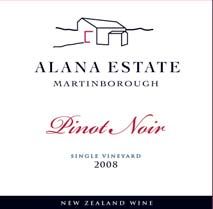 2008 Alana Estate Martinborough New Zealand Pinot Noir 14.3% alc., pH 3.76, 2,500 cases, $39.99, screw cap. Grapes were hand picked and 100% de-stemmed. Aged in French oak for 10 months and settled in stainless for an additional 5 months. Unfined and unfiltered. Bottled July 3, 2009. · A black cherry bombast in the nose and on the palate. A hint of cola and spice add interest with oak playing a subtle supporting role. The most striking feature of this wine is the velvety texture. Beautifully crafted and perfectly harmonious, this is a complete wine. One of the best Pinot Noirs I have ever sampled from New Zealand.
Alana Estate Pinot Noir will be available in the United States November 1, 2009. A portion of the United States allocation is being made available first to the mailing list through the U.S.-based website, www.alanestate.com, that will launch October 1, 2009. Some wine will be sold through a select number of fine wine stores and restaurants, primarily in CA, AZ, NV, MI, TX, and NY. The wine will be poured at the International Wine and Food Festival in Grand Rapids, MI in November, 2009.
ampelos: Little Winery that DidAmpelos Cellars is a small, family owned winery established in 2000 in Lompoc, Santa Barbara County. Proprietors Peter and Rebecca Work are proud of their recent certifications for the winery’s 25-acre estate vineyard in the Sta. Rita Hills. It became the first vineyard in Santa Barbara County and one of the first in the country to be certified sustainable, organic and biodynamic. Sustainability in practice (SIP) was obtained from the Central Coast Vineyard Team. Sustainability addresses the whole farm with focus on environmental stewardship, social and economic equity, and economic profitability. Organic certification from the governing body, Stellar (USDA), represents a further extension of sustainability. Organic farming means using no synthetic products, relying only on natural fertilizers and employing natural pest control systems to care for the vines. Organic farmers also use minimal filtration and fining materials and often natural yeasts. Biodynamic certification was received by Demeter®. Biodynamic practices are aimed at establishing a state of natural balance in the vineyard. The farm is viewed as an ecological, self-sustaining system. Biodynamie harnesses the earth’s cycles according to moon phases and gravitational forces to enhance fruit flavor, production and heartiness. The farm follows the earth’s schedule, not the farmer’s! The ampelos Vineyard is planted to Pinot Noir and Syrah, with small amounts of Grenache and Viognier. Planting began in 2001 and the first harvest from ampelos Vineyard was in 2004.
 Peter is a Danish national and former information technology consultant who dreamed of owning a vineyard and making his own wines. Rebecca is a former Alaskan resident who had similar intentions. Together, they bought an 82-acre property in the Sta. Rita Hills in 1999. Ampelos is a Greek word meaning “vine.” The Greek connection derives from the Works’ love for Greece and their guest house on Folegandros in Greece’s Cycladic Island group where they were married and still spend time together each year. The Works left their corporate jobs and moved to their property in 2002. Their son, Don Schroeder, was the consulting enologist at Ampelos until 2008 when he left to become the winemaker at Sea Smoke. Today, the Works carry on the winemaking duties. Total production is 3,500 cases which include Pinot Noir, Syrah, Grenache, a Syrah-Grenache blend, Viognier and Rosé. The wines come from both the ampelos Vineyard and purchased grapes from Santa Barbara County. The Works also supply grapes to Brewer-Clifton, Jaffurs and Samsara for their vineyard-designated ampelos Vineyard bottlings. The two primary Pinot Noirs are “lambda,” from the ampelos Vineyard and “rho,” composed of the top 20% of the barrels from ampelos Vineyard. A third vineyard, Fiddlestix, has been discontinued, but additional sources have been acquired. The Works also sell an interesting white wine crafted by their son labeled Chien Edelzwicker, a blend of Riesling, Pinot Blanc and Gewürztraminer, the noble grapes of Alsace.
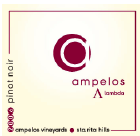 2006 ampelos Cellars “lambda” ampelos Vineyard Sta. Rita Hills Pinot Noir 14.4% alc., pH 3.51, 1,059 cases, $35. Third harvest from this vineyard. Clones 115 (61%), Pommard (31%), 667, 777, 828. New blocks interplanted with Pinot Gris to facilitate cofermentation and co-pigmentation (to obtained darker color). 100% de-stemmed, 3-4 day cold soak, inoculated yeast, 80% free-run with gentle press wine added using manual basket press. Racked to 30% new French oak barrels and inoculated with MLF bacteria. Aged in barrel 17 months. · Moderately light garnet color. Vivid black cherry aromas with a hint of baking spice and the faintest oak. Very tasty medium-weighted flavors of cherries and raspberries with a touch of spice and citrus. Soft, smooth and clean with minimal ripe tannins and a good grip of acidity in the background. Well-bred and well-crafted. This Pinot Noir is what many aspire to, but most fall short of. Great value as well.
Ampelos Cellars wines are available on the website at www.ampeloscellars.com. To really understand and appreciate these fine wines, you should visit the winery at 1633 W Central Ave, Ste. B, in Lompoc on Saturdays and taste with the Works. Tasting is available by appointment on other days as well (805-736-9957).
Road 31 Wine Co.: One Truck, One PinotRegular readers of the PinotFile know that I have been a fan of the Pinot Noirs from Kent Fortner since the first vintage in 2001. From 2001 to 2005, the winery was known as Green Truck Cellars, morphing to Road 31 Wine Co. with the 2006 vintage. Kent says that he was doing some family research in his hometown in Kansas when he saw a sign posted to a gravel road, “Road 31.” This road ambled past his grandparents’ homestead in Kansas. Kent’s 1966 green Ford truck, willed to him by his later grandfather, traveled Road 31 frequently. He decided to make the name change, thinking there were just too many truck labels, but he retained the picture of his green truck on the front label. Kent crafts his Pinot Noir in a portion of a barrel cave made available by friends who live in the Stag’s Leap District of Napa Valley. He is a one-man operation and likes it that way. His hands handle every step of the crafting from fermenting, to barrel aging, to bottling and peddling. He even delivers wine in his green truck whenever possible. Kent crafts roughly 700 cases of one wine: Road 31 Wine Co. Napa Valley Pinot Noir. Recent vintages are sourced from three vineyards: Nord Vineyard, located at the southern mouth of the Napa River where the water spills into the San Francisco Bay (clone 115), Stanly Ranch Vineyard in Carneros, just across the Napa River from Nord (114), and Suscol Ridge Vineyard, a mountain vineyard in Napa (Pommard). For Kent, the 2007 vintage was, “Truly a dream. We had cool weather, but not so much that botrytis invaded. We had a drought, but not so severe that we ran out of water entirely, resulting in perfectly stressed vines. We had extremely low yields with clusters so small that four of them would fit into your hand. Finally, we had shockingly even weather at harvest. Truly, a dream vintage.” As far as winemaking went, Kent said, “I couldn’t believe I managed to get through the perfect vintage without screwing it up.” The result is the best Pinot Noir Kent has ever produced.
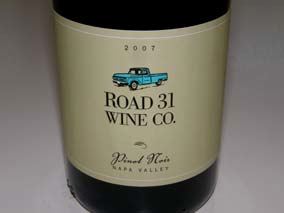 2007 Road 31 Wine Co. Napa Valley Pinot Noir 14.1% alc., pH 3.62, 800 cases, $39, released June 1, 2009. Low yields, great color, brown stems. Low juice to skin ratio. The wine sat on its gross lees without racking for a year in barrel. · Opens beautifully in the glass over time revealing a complex aromatic profile of cherries, berries, spice, brioche, and forest floor. Vivid and full-bodied flavors of black cherry and black berry jam caress the palate with an attractive underlying earthiness and savoriness. Soft and smooth in the mouth leading the wine to literally slip off the back of the palate. A juicy and seamless wine that is nicely crafted and well priced. Way too good for the dog.
2006 Road 31 Wine Co. Napa Valley Pinot Noir 14.2% alc., 950 cases, $39. · Very charming aromas of ripe berries and cherries with a hint of cola. Earth-kissed black cherry and black raspberry flavors. A soil-infused, medium-weighted wine of great interest showing supple tannins, admirable finesse, and a dry finish. A solid wine, but not quite as good as the 2007 vintage.
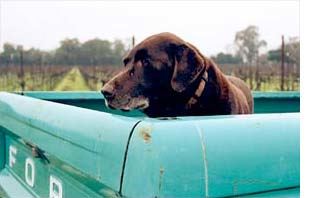 Road 31 Wine Co. Pinot Noir is sold primarily to “truckers” on the mailing list with limited retail distribution. The 2006 and 2007 vintages are sold out, but may still be found through retail channels. Add a case to your cellar and your friends will be green with envy (sic). The website is www.road31.com and the phone is 707-649-1200 (tasting by appointment). An informative “plog” is available on the website.
Pfendler Vineyards: Hollywood to VinesPfendler Vineyards was launched by Kimberly Pfendler in 2007 to honor the legacy of her husband, Peter Pfendler, who first planted the Pfendler Vineyards in 1992. Peter, who passed away in 2007, was a man of many accomplishments. He graduated from the U.S. Air Force Academy and served as a distinguished fighter pilot in Vietnam. Later, he obtained an MBA from UCLA and a degree from Harvard Law School and had a successful business career. Peter founded Polaris Aircraft Leasing Corporation in 1974, which became the world’s largest commercial aircraft leasing company. In 1989, he sold Polaris to General Electric Corp., and bought a ranch just east of the town of Petaluma in Sonoma County. He pursued his life long dream of cattle ranching, wildlife and land conservation, and later, planting vineyards and growing grapes.
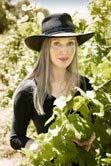 Kimberly was a successful Creative Executive in the Hollywood film industry. After earning a degree from UCLA Film School, she worked at both Warner Brothers and MGM studios where she developed a series of hit films. She married Peter in 2004, trading her Hollywood glamor for a life close to the land. The drive and passion she developed in Hollywood has given her the tools to launch a luxury wine brand. The Pfendler vineyards consist of 19 acres of Pinot Noir and Chardonnay on four estate vineyards. Peter was the first to plant vineyards at the Petaluma Gap’s Crown, a very cool and windy area. The Penngrove Vineyard is a 6-acre parcel in this region planted to Chardonnay and Pinot Noir (clones 114, 115, 777, 828 and Swan). The fruit from this vineyard previously went into the Copeland Creek label. The Pullis Vineyard is the coolest and foggiest vineyard, situated on the base of a mountain just east of Petaluma. It was planted to clone 828 in 2005. Pfendler Vineyard is part way up the mountain and was planted to Bordeaux varieties in 1992. Located at 1,200 feet in the middle of the fog line, it was budded over to Chardonnay (Hyde clone) and Pinot Noir (Pommard clone) in 2008. The Helgren Vineyard sits at 2,000 feet on the mountain top and was planted in 2005 to Calera and Swan selections of Pinot Noir. This vineyard will make its debut in 2009. Noted winemaker and viticulturist, Greg Bjornstad, has been hired as winemaker. Greg was the viticulturist at Joseph Phelps Vineyards and Newton. In 1996, he joined Flowers Vineyard & Winery as vineyard manager and assistant winemaker. Flowers was awarded the title, “Artisan Winery of the Year,” by Wine & Spirits magazine two years in a row while Greg worked there. In 1999, he launched an international vineyard consulting business and has assisted winegrowers in Russia, South Africa and Australia, and well-known stateside clients such as DuMOL, Hirsch, Kistler, Kosta Browne, Paul Hobbs, Pisoni and Scott Paul. He founded his own label, Bjornstad Cellars, in 2005, specializing in vineyard-designated Pinot Noir and Chardonnay from the Sonoma Coast, Russian River Valley, Bennett Valley and Sonoma Mountain appellations. Bjornstad’s winemaking starts with vigorous sorting followed by native yeast fermentations. The barrel aging program uses 50% new French oak. Pfendler’s Pinot Noir and Chardonnay receive 8 months of sur lees aging, and are racked twice before the wines are bottled unfined and unfiltered. The 2007 Pfendler Vineyards Pinot Noir and Chardonnay were sampled over dinner with Kimberly Pfendler. I was impressed by her passion and commitment and I believe this label can compete with the best from California. 2007 Pfendler Vineyards Chardonnay (see feature on Chardonnay, page 21)
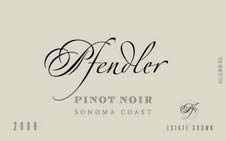 2007 Pfendler Vineyards Sonoma Coast Pinot Noir 14.6% alc., 350 cases, $45. Clones 114, 115, 777, 828, and Swan. 100% de-stemmed, 7-day whole berry cold soak, 8 months sur lees aging. Aged 11 months in 50% new French oak. · A medium bodied Pinot Noir with charm and balance. Still young, needing 45 minutes to fully open in the glass. Sweet, scented nose of plums and blueberries with gentle oak which are echoed in the flavors. The most striking feature is the wine’s silky texture. Tres Pinot.
The inaugural 2007 vintage for Pfendler Vineyards produced 550 cases of Pinot Noir, Chardonnay and Rosé. Production will double with the 2009 vintage as the family’s newest vines come of age. The wines are sold through a mailing list at www.pfendlervineyards.com.
Harrington Wine: Urban StarHarrington is part of the popular San Francisco urban wine movement, located in a warehouse in the Produce District. Proprietor and winemaker Bryan Harrington is a Pinot Noir specialist who has achieved a quiet following and his wines are truly worth your interest. I first became interested in Harrington wines after tasting them at the World of Pinot Noir in 2006. The wines stood out for their individuality and deft winemaking. While working as a bartender in San Francisco, Harrington traveled to Europe and became enamored with the very small producers who were tending tiny vineyard plots and crafting a few barrels of wine. It was a model that he eventually was to pursue. He began making wine in his basement in San Francisco, attended several University California Davis classes, and moved on to a cooperative winemaking facility in Berkeley. He finally started his own label in 2002 and settled into his present location in San Francisco. His wines are crafted in an artisan fashion with no wine made in larger than a 300 case lot. Bryan says, “It is my responsibility each year to use every means possible to bring a fruit-full and authentic wine experience to your glass.” Most Harrington vineyard sources are at least 30 years old and nurture California’s older heritage clones. Bryan notes, “Vineyard sources have been chosen not only for their age and quality, but also for their ability to convey those characteristics that typify the particular Pinot Noir appellations, whether it be the firm structural elements of wine from the limestone of Chalone, the dark fruit flavors of the Sonoma Coast rocky ridge tops, or the racy Bing cherry profiles from the Goldridge soils of the Russian River Valley. The winemaking approach is biased to accumulate the particular flavors and aromatics natural to each site.” Photo below shows Bryan (left) and partner Ken Zinns pouring at the 2009 Anderson Valley Pinot Noir Festival.
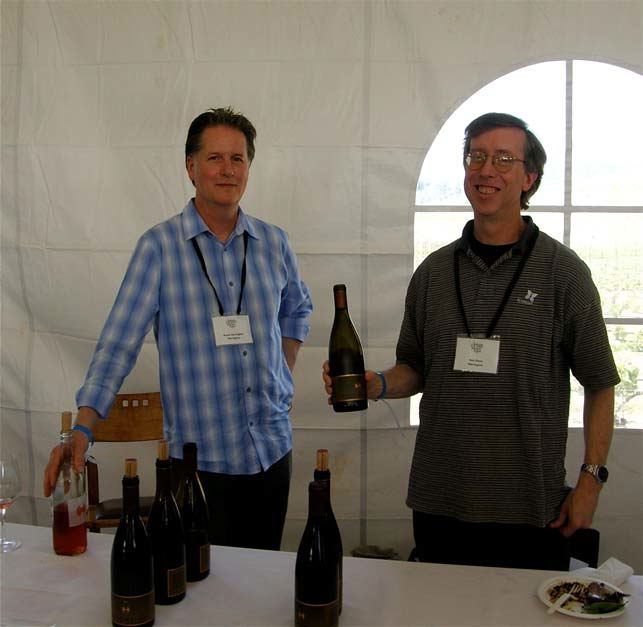 I recently sampled the four 2007 Harrington Pinot Noir releases. As Bryan promises, each wine speaks of its location and has an appealing individualistic style and personality. Also, all four wines retain the finesse and delicacy that Pinot Noir is known for and I like this. All fermentations are driven by natural and inoculated yeasts.
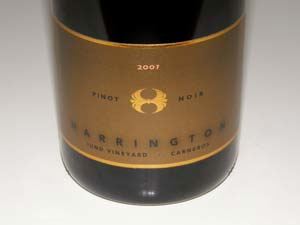 2007 Harrington Iund Vineyard Carneros Pinot Noir 14.0% alc., pH 3.41, 258 cases, $40. This vineyard is 25-years old with the 2007 vintage. Martini clone. Aged 10 months in 30% new French oak. · This is a comfortable wine that speaks of fruit in the redder spectrum. Dried cherries are most evident with echoes of spice, oak and tomato. Light to medium-bodied, the mouth feel is all silk and satin. Not an extraordinary wine, but a very fresh and juicy drink driven by crisp acidity.
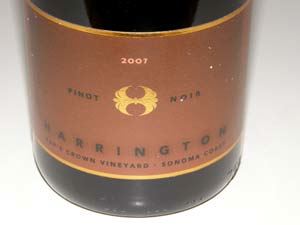 2007 Harrington Gap’s Crown Vineyard Sonoma Coast Pinot Noir 14.3% alc., pH 3.58, 304 cases, $45. The vineyard is located on a hillside at the cool southeastern edge of the Petaluma Gap, close to the town of Penngrove. The wind and fog funnel in from the Pacific Ocean, keeping acidity high in the grapes and allowing slow maturation. The soils is extremely rocky, de-vigorizing the vines. Clones 828, 667, 115 and Swan. Aged 10 months in 50% new French oak. · Appealing scents of black cherry jam lead to cherry-driven flavors with a hint of cola. The cherries really sing. Great fruit purity, smoothly textured, fine-grain tannins and a clean finish. Straight forward and lacking some power, this is still very pleasing juice.
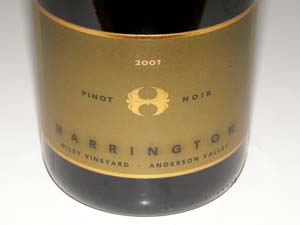 2007 Harrington Brosseau Vineyard Chalone Pinot Noir 14.8% alc., pH 3.52, 132 cases, $50. This site is known for the limestone strata pushed up from a million-year-old seabed by the nearby volcano. Clone 538. Aged 10 months in French oak. · With some time in the glass, this wine explodes with bright black fruits enhanced by aromas of restrained oak-driven spice and toast. More fullness, more creamy fruit and more pizzazz than other wines in the lineup. The black raspberry and blackberry fruit core is mouth filling but not jammy. Despite its prodigious fruit, this is a pretty wine that finishes light with a memorable lingering aromatic presence. There is a healthy tannic backbone and perfectly balanced acidity predicting good age ability. The best wine I have ever had from this vineyard.
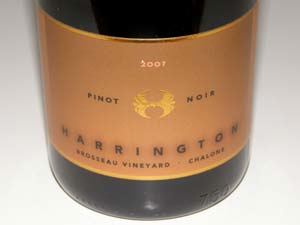 2006 Harrington Wiley Vineyard Anderson Valley Pinot Noir 14.1% alc., $40. This vineyard is a little-known gem and the wines I have sampled from here are terrific. · A nose of great interest featuring ripe cherry compote, newly-sawed oak and a touch of good barnyard funk. Dark cherry and berry flavors with riffs of loamy earth and oak, fine-grain tannins, finishing with a fruity persistence as it slips off the back of the palate. This wine held up beautifully in a sampling throughout the day.
Harrington wines are sold to a mailing list at www.harringtonwine.com. Look for Bryan Harrington pouring at San Francisco Urban Wineries events sponsored by the Winery Collective. The Winery Collective is a collection of small winemakers dedicated to producing artisan wines (www.winerycollective.com). Harrington wines are available for tasting seven days a week at Grange Sonoma, another tasting room collective located in Sonoma at 23564 Arnold Drive on Highway 121 (www.grangesonoma.com).
Taft Street Winery ReinventedI can remember drinking Taft Street wines in the early 1980s when I was developing a passion for wine. The Tierney brothers from Berkeley, John and Mike, joined Mike Martini to form Taft Street in 1979. John and Mike Tierney cooked in nearby restaurants part time while undergraduates at Cal, and started making wine. John graduated from Cal and moved to Sonoma County to work at Souverain Winery. He returned to Berkeley to be the winemaker at Wine and the People where he met Mike Martini. The Tierney’s house on Taft Street in Oakland was built in 1918, and its garage was so small that a car could no longer fit comfortably inside. The brothers decided to turn it into a winery, a true garagiste winery. A few years later they moved to a winery in Sonoma, releasing their first wine in 1982. Robert Parker, Jr., rated their wines highly and the label became quite well known. By 1990, they were producing 20,000 cases of good wine. Unfortunately, Taft Street wondered off the original intended course and was bought by a Manhattan, New York importer. The label soon faded into obscurity. Mike Tierney and Mike Martini have resurfaced and reinvented Taft Street eight years ago. Their tagline is “Garagistes since 1979.” The winemaker since 2007 has been Evelyn White (formerly at Clos Du Bois) and the wines have been solid since that time. The principals are holding to a policy of reasonable prices, quality grape sourcing and moderate production. The grapes are brought in from the Russian River Valley, Sonoma Coast, Alexander Valley and Dry Creek Valley. Several varietals are produced including Chardonnay ($17 to a $30), Sauvignon Blanc ($16), Pinot Gris ($16), Riesling ($16), Gewürztraminer ($16), Merlot ($15), Syrah ($22), Zinfandel ($24) and Rosé of Pinot Noir ($16) and Pinot Noir ($20 to $36).
 2006 Taft Street Sonoma Coast Pinot Noir 13.9% alc., pH at harvest 3.64, 4,981 cases, $16. Sourced from several vineyards in the Sonoma Coast appellation with a good portion from Art Ibleto’s Bella Sonoma Vineyard. Fermented in open-top stainless steel tanks with three daily punch downs. Pressed to 45% French oak and 55% American oak and aged for 14 months. · Aromas of black cherries, burly oak, green garden, forest floor and a little barnyard. Dark cherry and berry flavors with a hint of oak. Decent richness, supple tannins and bright acidity. Good value.
 2006 Taft Street Garagistes Mendocino Ridge Vineyard Mendocino County Pinot Noir 14.5% alc., pH at 3.27, 326 cases, $36. Sourced from Joe Keith’s vineyard in the Mendocino Ridge AVA.Fermented in open-top stainless steel tanks with three daily punch downs. Pressed to 30% new French oak for 14 months aging. · Lovely, demure aromas of cherries and berries. Bright, intense raspberry fruit on the attack with an underpinning of earth and oak. Soft and sensual like a cashmere sweater. Harmonious with ephemeral tannins and admirable persistence on the finish. A generous, enjoyable wine.
Taft Street wines can be enjoyed at the winery’s tasting room located at 2030 Barlow Lane in Sebastopol. Open Monday through Friday from 11:00 to 4:00 and on weekends to 4:30. The wines are sold online at www.taftstreetwinery.com.
Van Duzer : Corridor Makes the PinotThe Van Duzer Corridor is the only break in Oregon’s Coastal Range that borders the western side of the Willamette Valley. This corridor or gap allows Pacific Ocean air to flow eastward into the Willamette Valley, moderating summer heat. The influence of the Van Duzer Corridor extends inland to the McMinnville and Eola- Amity Hills appellations as well as the vineyards in the Dallas area of the Willamette Valley. The Van Duzer Corridor is named after Henry Brooks Van Duzer, a New York native who had a long career with the Inman-Poulsen Lumbar Company, one of Oregon’s largest lumbar firms. He was Chairperson of the Oregon State Highway Commission for eight years and during his tenure, there was a significant increase in much-needed highways in Oregon. To formally recognize him, the corridor was named in his honor. In 1998, Carl Thoma, managing partner of Chicago-based Thoma Cressey Equity Partners and his wife Marilynn bought the run-down Van Duzer Vineyards property. The couple had developed an enthusiasm for wine when they both attended Stanford University to study for their MBAs. Thomas had been a managing partner in Parducci Wine Estates in California, and like so many Oregon wineries before, Van Duzer benefited from an enthusiastic outside investor. Jim Kakacek was hired to upgrade the estate’s 65 acres of vineyards, manage the winemaking, and direct construction of a new winery. New plantings of Pinot Noir were complemented by field grafting of Dijon clones to 15-year-old established Pinot Noir vines. Vineyard plantings now total 82 acres and include Pommard, Wädenswil, and Dijon 113, 115, 667 and 777 clones. Two clones of Pinot Gris are also planted. The vines have 9’ x 4’ spacing and VSP trellising which improves light penetration spray coverage, disease resistance and induces moderate stress in the vines. By 2001, the efforts began to show in the wines and success has followed. The new winery was finished in time for the 2006 harvest, increasing capacity to 20,000 cases when the entire estate is producing. The old winery was a source of brettanomyces in Van Duzer wines and was part of the Van Duzer ‘style’ in the 2002, 2003 and 2004 vintages. The problem was curtailed by 2005 and eliminated beginning with the 2006 vintage when all wine was vinified in the new winery. Recently, horticulturalist Rebecca Sweet has been hired to manage vineyard operations at Van Duzer. The vineyards are LIVE certified. All wines are 100% estate fruit and production is divided between wines that represent the entire estate and block-designated wines of special pedigree. The Van Duzer label is inspired by Zephyr, the Greek mythological goddess of the gentle West Wind, who blows Pacific breezes over the estate’s hillside vineyards. The estate is located 60 miles south of Portland and west of the Eola Hills and Salem in the eastern mouth of the Van Duzer Corridor three miles off Highway 99W. Because of its location, summer temperatures in the vineyard drop sooner in the afternoon than in the vineyards to the North or south by 13 degrees. The result is extended hang time.
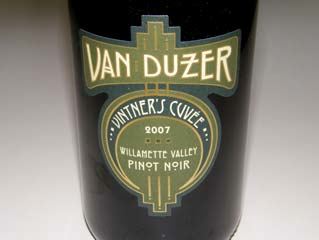 2007 Van Duzer Vinter’s Cuvee Willamette Valley Pinot Noir 13.1% alc., pH 3.59, 4,500 cases, $20. A blend of six Pinot Noir clones with a focus on the younger vines on the estate. After cold maceration, yeasts are chosen specifically for each clone to enhance and preserve the terroir. Aged in 35% new, 30% once-used, and 35% neutral French oak barrels for 8 months. · Complex aromatic profile of dark raspberries and plums, smoky oak, spice and graham. Moderately rich dark fruits with a hint of root beer and oak in the background. Soft tannins and a very pleasing smooth mouth feel. A solid daily drinker.
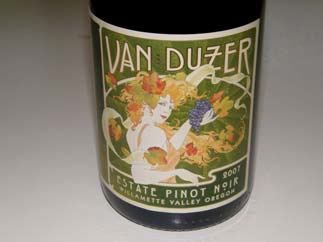 2007 Van Duzer Estate Willamette Valley Pinot Noir 12.7% alc., pH 3.52, 7,500 cases, $30. After selective harvesting, the grapes were gently destemmed and fermentation was immediately started by inoculating yeasts. Fermentation lasted two weeks with selected tanks undergoing extended maceration post-fermentation to balance the tannins and other components. Aged for 10 months in a mixture of new and older oak barrels. · Moderately light garnet color. Very attractive pure and bright aromas of dark red stone fruits and berries with a note of oak-derived roasted marshmallow in the background. Light in weight but flavorful, with attractive tastes of dark red fruits, earth, mushroom, and oak. Very silky and refreshing with an appealing gentleness.
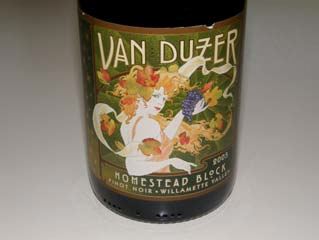 2005 Van Duzer Homestead Block Willamette Valley Pinot Noir 13.05% alc., pH 3.64, 300 cases, $45, May 2009. Pommard clone vines located where the original homestead of this property was located. The vines are nearly 30 years of age. This is the fourth Homestead Vineyard-designated bottling. 100% de-stemmed, cold macerated, aged 9 months in 50% new and 50% one-year-old French oak barrels and then returned to the barrels for 5 additional months of aging. Bottled by hand, unfined, and allowed to bottle age 2 years before release. · Moderately dark reddish-purple color. Darkly fruited aromas, particularly mu shu plum sauce and black raspberries, draw you into the glass. Earth-dusted black fruits cascade through the palate still encased in noticeable but refined tannins. Oak plays a supporting role in the background. A full-bodied fruit-driven wine displaying the appealing smooth texture characteristic of all the Van Duzer Pinot Noirs. This wine is still a Lolita and will benefit from even further cellaring. Decant if you can’t wait.
The Van Duzer tasting room is open daily from 11:00 to 5:00, March 1 through December 30, or by appointment (800-884-1927). The tasting room, located at 11975 Smithfield Road in Dallas, has a grand view of the vineyards and the Baskett Slough Wildlife Refuge. Winery tours are available by appointment. The Van Duzer lineup of Pinot Noirs and Pinot Gris are available online at www.vanduzer.com with some retail distribution. Older vintages of some wines are available.
Vergari: Letting Wines Find Their VoiceI have met David Vergari on several occasions and I am always impressed by his philosophy. He says, “Wine is dynamic, going down many paths on its way to becoming something unique. Often times I help it along. Sometimes the best choice is to do nothing and let the wine find its voice over time.” Vergari (below at the 2009 World of Pinot Noir) admits that the majority of his winemaking goes on in the vineyard, in concert with the people who watch over the vines.
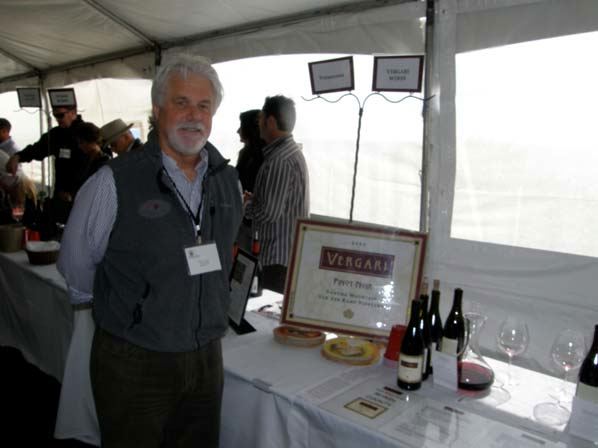 Vergari’s life long interest in wine is attributable in part to his Italian ancestry. His first memory of wine occurred when he was five years old in his great-uncle’s cellar in San Francisco where he sampled “Dago Red,” cut with water, of course. He began his working career as a financial analyst, but winemaking was in his blood. He began his winemaking career with internships at Sonoma-Cutrer and The Hess Collection in California, and work abroad at Coldstream Hills in Australia and Covisa in Spain. Returning to California, he became a research enologist at Joseph Phelps Vineyard before becoming the winemaker at Rutz Cellars, and later at Maddalena Vineyards. In 2003, he founded his namesake label Vergari Wines. Vergari crafts Pinot Noir and Cabernet Sauvignon at Owl Ridge Wine Services in Sebastopol, California. He divides his time between the winery and vineyards in Northern California and his home life with Katie Orth in Sierra Madre, Southern California. His dedication and talents have turned his winemaking dreams into quite a success. A few months ago, I sampled a trio of Vergari’s Pinot Noir releases. His vineyard sources are carefully selected and superbly farmed. The Van der Kamp bottling is clearly the star. Winemaking employs careful sorting, 3 to 6 day cold soak, native yeast and native malolactic fermentation, 20%-30% new French oak, and aging for 11 months.
2006 Vergari Marin County Pinot Noir 14.4% alc., pH 3.63, 145 cases, $36, released Fall 2008. Vineyard in the Chileno Valley is farmed by noted viticulturist Mark Pasternak. Heritage and Dijon clones. Aged in 33% new French oak for 11 months. · Shy but pleasing red fruit aromas touched by herbs. Cherry-driven on the palate in an elegant style. Gossamer tannins and well-appointed acidity. Doesn’t excite, but decent.
2006 Vergari Sangiacomo Vineyard Sonoma Coast Pinot Noir 14.2% alc., pH 3.61, 178 cases, $42, released Fall 2008. Sourced from the Roberts Road Vineyard located in the Petaluma Gap and farmed by the Sangiacomo family who have been mainstays in Sonoma County for several generations. Pommard and Dijon 115 clones. Yields less than 1.5 tons per acre. Aged on fine lees in 20% new French oak for 10.5 months. Released after 13+ months of bottle age. · Scents of blackberries and cranberries with subtle oak, exotic woods and herbs. Medium-weighted red fruits with a slight olive oil and oak underpinning. Elegant with supple tannins and bright acidity.
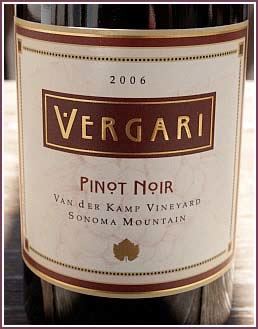 2006 Vergari Van der Kamp Vineyard Sonoma Mountain Pinot Noir 13.5% alc., 135 cases, $45. Heritage clones and Dijon 777. Low yields. · Dark reddishpurple color. Beautiful aromatics that really draw you in. Deep, dark fruits including black raspberries and mu shu plum sauce. Full-bodied and mouth coating black fruits with an earthy underpinning. Velvety tannins frame the lush fruit perfectly and the dry finish lingers memorably. The pedigree of this vineyard shows through in this excellent wine.
The famous Van der Kamp Vineyard is located near the top of Sonoma Mountain at 1,200 feet on a north-facing slope. Martin, Dixie and son Ulysses Van der Kamp, have planted most of the California heritage clones as well as the newest Dijon clones. The soil is a reddish volcanic loam, varying from intense rocky slopes above the “Red Shoulder” area to deeper, browner, but still volcanic clay loam in the “Horn Section.” Martin has been farming this ranch since the late 1950s. It is written that the vineyard contains the oldest block of Pinot Noir planted in Sonoma County, but I believe Hanzell’s 1953 block is the oldest. Ulysses is now farming the vineyard armed with the knowledge of his father and employing the latest in viticultural techniques. Ulysses likes to say, It’s easy to grow Pinot Noir. That is, if you’re willing to work twelve hours every day.” Vergari talks about a mystical, spiritual feeling at the vineyard. “Tibetan flags flutter in the breeze, mating pairs of hawks fly overhead....the land speaks to me.” Van der Kamp Vineyard supplies grapes to many of California’s most notable producers including Bjornstad Cellars, Berridge Wines, Landmark Vineyards, Novy (Pinot Meunier), Ryan, Siduri and Tandem. Vergari wines are sold on the website at www.vergariwines.com and through fine wine retail stores (listed on the website. 626-818-8398.
Monterey County: Great Pinot ValuesMonterey County winegrowers are prospering in this recession as consumers seek out more value priced wines. With 42,000 acres planted, Monterey County has only slightly less vineyard acreage than Napa Valley (43,000 acres). 75% of Monterey County grapes are sent out of the county to be incorporated into wines from Napa and Sonoma that often say, “California” on the label. This trend is slowly changing as Monterey gains more cachet among consumers. Many wineries both in and outside of Monterey County are now bottling Monterey County appellation wines, including Pinot Noir. Pinot Noir thrives in the northern parts of Monterey County including the Carmel Valley, Chalone, Arroyo Seco and Santa Lucia Highlands appellations (see map below). The plum of Monterey County is the Santa Lucia Highlands. This prestigious grape growing region sits directly opposite the low-lying vegetable plains of the Salinas Valley. The maritime climate is well suited for Pinot Noir and Chardonnay, which represent 78% of the Santa Lucia Highlands appellation’s 5,500 acres of vineyards. The Pinot Noirs from this appellation are primarily vineyard-designated, with more appellation wines certain to appear as plantings increase and newer plantings come into production.
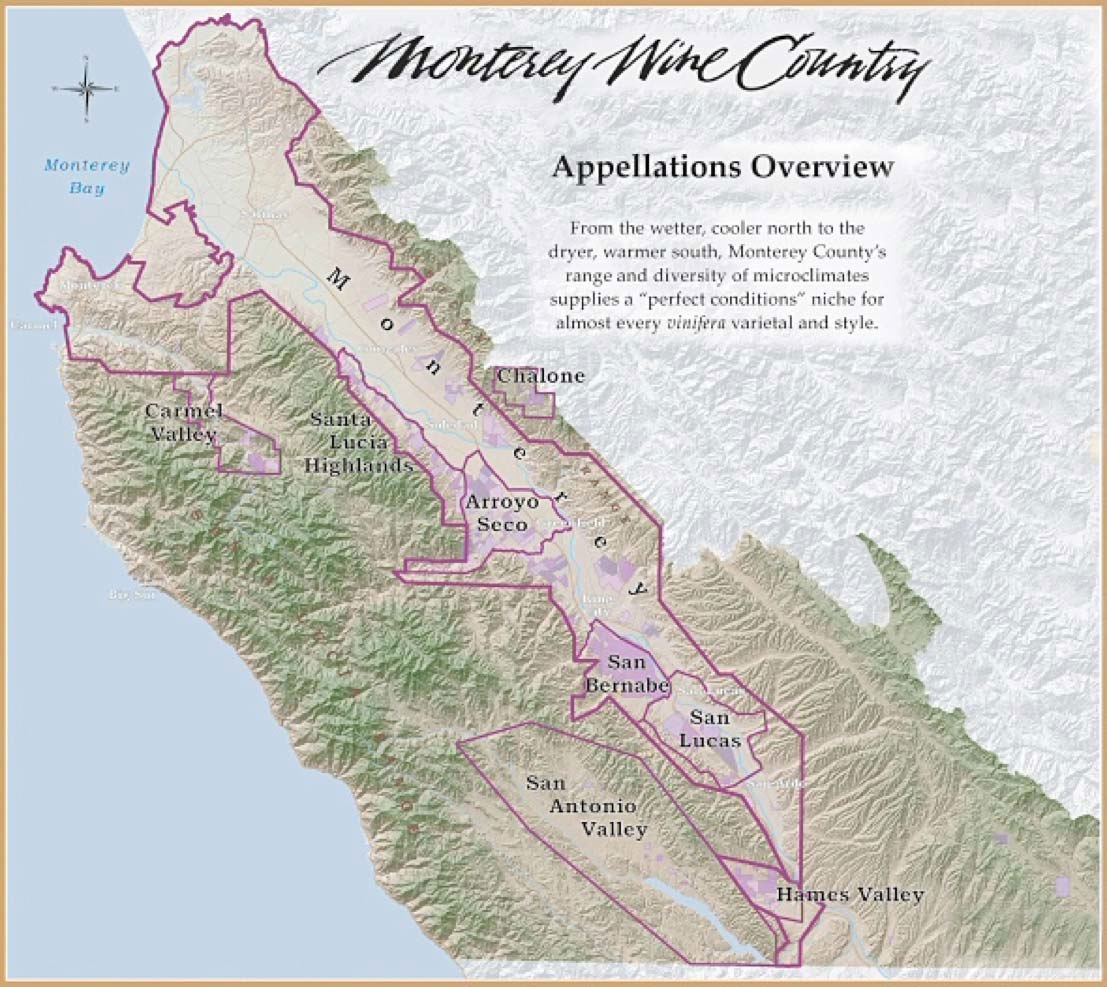 I recently sampled a number of value-priced Monterey County Pinot Noirs that are currently on the market. Monterey County has only 30 wineries, so many producers are located outside the Monterey appellation. The quality was consistently solid and this is a region to look to for reliable, value-priced, varietally true Pinot Noir. The Monterey Pinot Noirs tend to be darkly colored and well-endowed with dark fruits. Will success spoil Pinot Noir? Basically, there are three tiers of Pinot Noir from California and Oregon: (1) < $25, (2) $25-$60, and (3) > $60. The differences between the three tiers are subtle and often only detectable by experienced tasters. The average consumer may not see the justification for the higher priced wines. Is the $60 Pinot Noir three times better than the $20 Pinot Noir? In recent years, there has been a remarkable advance in quality of low-priced Pinot Noir from California and Oregon and this will certainly pressure the economic viability of higher priced examples of the varietal. Will there be enough Pinot geeks to support the multitude of high-priced Pinot Noirs? I had a subscriber recently cancel his subscription to the PinotFile saying, “I am tired of paying for overpriced California Pinot Noirs.” Only time will tell.
2007 Castle Rock Monterey County Pinot Noir 13.8% alc., $10. · Very dark ruby color. On the nose the dark fruit is overshadowed by some fecal notes (organic) with hints of spice and stem. Tasty sweet dark fruits on the macho attack with respectable persistence on the finish. Smoothly textured with supple tannins. People will like this wine. Tastes much better than it smells.
2007 Poppy Monterey County Pinot Noir 13.5% alc., $10. · Slightly confected strawberry aromas wrapped in sweet oak with a touch of funk. Decent, but dilute, black cherry flavors with an oaky edge. Supple dry tannins make for easy drinking.
2007 Chalone Vineyard Monterey County Pinot Noir 13.5% alc., $15. · Attractive cherry and raspberry scents veering toward raisin. More redder fruited than many wines in this lineup featuring summer strawberries and raspberries with a touch of tutti-fruity and sassafras. Flavors are on the ripe side.
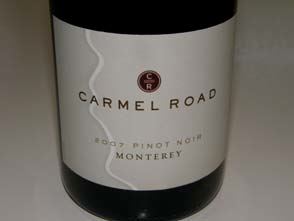 2007 Carmel Road Winery Monterey Pinot Noir 14.0% alc., $16. From Arroyo Seco vineyards in Monterey County where most mornings the vineyards are shrouded in fog. Afternoon breezes from the Pacific Ocean deliver cool, maritime air. This winery has specialized in Pinot Noir and Chardonnay from Monterey since 1999 and was a featured winery at this year’s International Pinot Noir Celebration. The winemaker is Ivan Giotenov. · On the nose there is intense black cherry and raspberry scents with a touch of fig and floral breeze. Delicious black cherry core that is juicy and satisfying. Silky textured with a clean and refreshing finish. One of the better value-priced Monterey Pinot Noirs.
 2007 Paraiso Santa Lucia Highlands Pinot Noir 14.3% alc., $16. Pronounced “pa-rye-zo,” a name given to the early Spanish explorers “Because it was like heaven.” The Smith family has practiced sustainable farming for 35 years on this estate. · Dark fruits are prominent on the nose which has an appealing underlying minerality. Light on the palate with mild ripe dry tannins and balanced acidity. Decent.
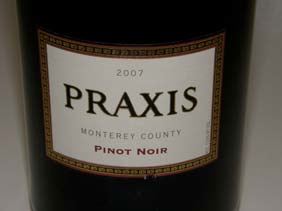 2007 Praxis Monterey County Pinot Noir 13.5% alc., $16. · Surprisingly good and very true to the varietal. Fresh berries and warm brioche on the nose followed on the palate with delicious compote of black cherries, blueberries and blackberries. There is a complimentary underpinning of smoky oak. Impressive mid-palate fullness but a bit thin on the short finish.
2007 Candela Mission Ranch Monterey Pinot Noir 14.5% alc., $20. Second label of Miura Vineyards. · Restrained dark fruits and crushed black grapes on the nose. Medium concentration of black cherries with some earth and tea influence. Decent.
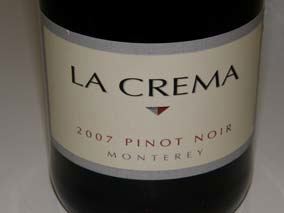 2007 La Crema Monterey Pinot Noir 13.8% alc., $24. · The aromas explode from the glass over time with heavenly scents of dark Pinot fruits, cardamon spice and a whiff of smoky oak. Perfectly composed with an array of flavors including plum, blackberry, raspberry, tea and smoke. A fruit-driven wine with a generosity that fills the mouth. Perfect harmony. Clearly, the best wine in this lineup.
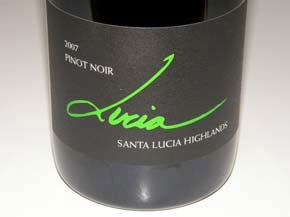 2007 Lucia Santa Lucia Highlands Pinot Noir 14.3% alc., $34. From the Pisoni family vineyards. · Powerful and very sexy deep berry and black cherry aromas with whiffs of roses and vanillin. Satisfying core of raspberry and blueberry fruit flavors with some persistence on the back end. Nicely balanced with reserved tannins and a soft texture. Highly recommended for an introduction to the gout de terroir of this appellation.
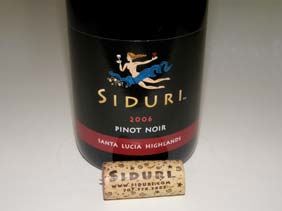 2007 Siduri Santa Lucia Highlands Pinot Noir 14.1% alc., $36. · Moderately light garnet color. Aromas of berries and cherries with competing notes of oak char and oak spice. On the palate there is respectable richness of black raspberry fruit with hints of tar and black tea. The tannins are soft and the finish is crisp and refreshing. The vein of noticeable oak that runs through this wine spoils the experience for me.
2006 Lockwood Vineyard Block 7 Monterey Pinot Noir 13.8% alc., $14. Estate grown and bottled. · Appealing aromas of black cherries, wildflowers, cedar and oak. Discreetly concentrated cherry and blueberry flavors with the tannic backbone to age. Very soft in the mouth. No complaints, just doesn’t thrill.
2006 Estancia Reserve Santa Lucia Highlands Pinot Noir 14.5% alc., $24. · Sourced from the Stonewall Vineyard Estate. Moderately deep reddish-purple color. Bright black cherry and strawberry perfume. Earthy dark red fruits with a hint of raisin, tar and oak on the palate. Medium-weighted with respectable silkiness and easy drinkability.
California Chardonnay TastingNo, the title is not a misprint. The PinotFile has now been published over eight years, and I have never done a feature on Chardonnay. Sure, I have reviewed an occasional Chardonnay from Oregon and California, but my focus and first love is Pinot Noir. My second love, and I finally have come out of the closet, is Chardonnay. Yes, I have dabbled in the world of ABC (“Anything But Chardonnay”), and I have enjoyed many bottles of Riesling, Sauvignon Blanc, Melon, and Pinot Gris. I keep returning to Chardonnay, especially the full-blown, barrel fermented, in-your-face, lush style of Chardonnay that is often criticized as too fashionable and food-unfriendly. Studies have shown that lovers of big, oaky Chardonnay are mostly male and over 60, so I fit right in. I lost my Chardonnay innocence 20 years ago to Kistler, whose wines have provided me many pleasures over this stretch, but I have recently found many other producers and styles to delight in. I am not such a Chardonnay H-bomb devotee that I don’t appreciate other styles of domestic Chardonnay. The Chardonnay camp seems to be split now into three groups. There are the advocates for nonoaked Chardonnay which is crisp, fresh and lean, 100% barrel-fermented Chardonnay, and “tweener” Chardonnay that combines barrel and stainless steel fermentation lots in the final blend. There are variations among these groups as well with some employing 100% malolactic fermentation and others using this technique only partially. Some winemakers such as Kevin Kelley of LIOCO have begun to ferment grapes on their skins, hoping to add another dimension to Chardonnay. The oaked Chardonnays feature a flavor profile of caramel, pineapple, vanilla, toast, butter and richness. The newer nonoaked Chardonnays emphasize focused and pure flavors of minerals and green apple. Think lean as opposed to fat. Chardonnay was not always the most popular wine in the United States. The Wente family in Livermore, California bottled the first Chardonnay in 1933 and labeled it Pinot Chardonnay, a term originated by and retained by the French for many years. The Chardonnays to follow from California, including those from Hanzell and Stony Hill, were often lean, age-worthy and Chablis-styled. Sales of Chardonnay were miserable
According to DNA fingerprinting, Chardonnay is the offspring of Pinot Noir and Gouais Blanc. Few mismatches have produced such a glorious offspring. Gouais Blanc and Pinot Noir were both planted in northeastern France in the Middle Ages and this is where they had a fling. Pinot Noir has become the grape of royalty, and Gouais Blanc has been banned in Burgundy and faded into oblivion. Chardonnay is often confused with Pinot Blanc, which looks similar and tastes somewhat alike. Pinot Blanc, however, is a white mutation of Pinot Noir, like Pinot Gris, with each sharing the same DNA. A third grape, Auxerrois Blanc, also confuses the picture, since some French nurseries sold vines labeled as Chardonnay that were Auxerrois. Auxerrois is an offspring of Pinot Noir. and planted acreage before 1970 was miniscule. It really took the now famous 1976 Paris wine tasting, at which Chateau Montelena Chardonnay won the top award for white wine, to fuel Chardonnay popularity. By the turn of this century, Chardonnay was ubiquitous in California. In 2006, according to Western Farm Press, Chardonnay was the largest acreage wine grape with almost 95,000 acres. 53% of all white vine vineyards in California by 2004 grew Chardonnay. The Nielsen Company, tracking the total U.S. food, drug, and major market liquor channel, reported in August 2009, that Chardonnay was the top selling varietal by far with a 22.1% market share in sales and 20.9% share in volume. Year-on-year, Chardonnay sales have increased 3.9% while case volume increased 4.9%. Regardless of what style of Chardonnay you prefer, one thing is certain. It is a whole lot easier to find good, even great, domestic Chardonnay, than Pinot Noir. Over the past six months, I sampled 50 domestic Chardonnays and the quality was remarkably high. Many of these wines are small production, expensive and strictly allocated through mailing list offerings. I have chosen to review below the 23 best examples I tasted. All but one are from California. Keep in mind my admission above regarding my stylistic preference.
2007 Lucas & Lewellen Santa Barbara County Chardonnay 13.7% alc., pH 3.33, 1,002 cases, $16. Sourced from younger vines of Los Alamos and Goodchild vineyards in northern Santa Barbara County. Stainless steel fermented. Winemaker was Megan McGrath. · Pale yellow color. Complex nose showing aromas of white peaches, pears, melon, lemons and spring flowers. The flavors echo the nose with a subtle edge of herbs and resin. Soft and clean with bright acidity. Perfect with turkey.
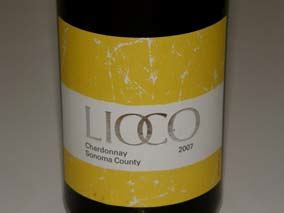 2007 LIOCO Sonoma County Chardonnay 14.5% alc., $19, screw cap. Fermented in stainless steel with wild yeast, 100% MLF. Aged in tank sur lees for 5 months. Unfined and unfiltered. · Scents of apple, lemon, honey, yeast and popcorn. Luscious and full-flavored with fruit that seems to jump out in the mouth. The essence of Chardonnay with flavors of pears, honey, nutmeg and nuts. Smooth and perfectly balanced. Best value in California Chardonnay on the market.
2007 LIOCO Demuth Vineyard Anderson Valley Chardonnay 13.8% alc., 225 cases, $35. The Demuth Vineyard is situated at 1,600 feet above the floor of the Anderson Valley. Wente clone is own-rooted in 1982. Whole cluster pressed, cold fermentation in stainless steel with wild yeast, natural MLF. 6 months lees contact. Unfined and unfiltered. No oak. · Terrific aromatics flashing ripe pears, green apples, warm cookies and graham. The flavors are reminiscent of a warm apple tart, with hints of apricot and toast. Smooth and creamy with a lively citric acid lift on the back end. Fresh and very bright.
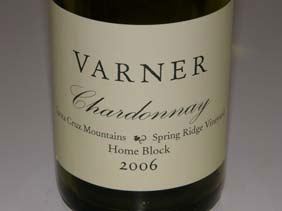 2007 Varner Spring Ridge Vineyard Home Block Santa Cruz Mountains Chardonnay 14.3% alc., $35. · Pale yellow color. Attractive aromas of yellow fruits, lemon custard and nuts. Creamy, yet full of zest and vigor on the palate with underpinnings of citrus zest, oak and stony minerality. Excellent value.
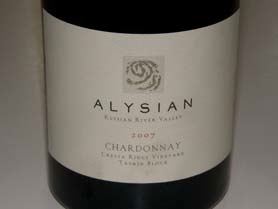 2007 Alysian Cresta Ridge Vineyard Taurin Block Russian River Valley Chardonnay 14.3% alc., $38. Pronounced “ah-liss-ee-uhn,” referring to an endeavor arising from intuitive creativity and artistic resolution. The inaugural Chardonnay from Gary Farrell’s new label. · A very pretty wine with aromas of honey and warm biscuits. Juicy flavors of lemon curd, pear and banana with a sidecar of smoky oak. Perfect fruit and acid balance with a seductively creamy texture. This one has the whole package.
2007 Pfendler Vineyards Sonoma Coast Chardonnay 14.2% alc., 150 cases, $38. Clone 4. Aged 11 months in 50% new French oak barrels. · A “tweener” Chardonnay with a moderately rich mid-palate and oak spice influence, but crisp and clean. Flavors of green apples, pear and citrus are supported by a spark of acidity.
2007 Harmonique Un-Oaked Anderson Valley Chardonnay 13.4% alc., 165 cases, $39. Grapes are from the 24-year-old vines at Conzelman Vineyard. Clone is believed to be Wente. Yields less than 1.5 tons per acre. Fermented in a combination of stainless steel and neutral oak for 8 months, then bottled and aged for 3 months before release. Inaugural vintage of this wine. Winemaker was Robert Klindt. · Citrus, butter and of tropical fruits on the nose. Great purity of citrus fruits with a hint of pear. Brisk acidity and a refreshing finish.
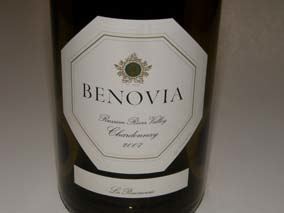 2007 Benovia La Pommeraie Vineyard Russian River Valley Pinot Noir 14.5% alc., $48. This vineyard is owned and farmed by George Martinelli and was once an apple orchard. Planted to high density Dijon 95 and Old Wente clones. · The name, La Pommeraie, French for apple orchard, fits this wine perfectly. Redolent of fresh green apples on the nose and palate with a perfect touch of toasted oak and citrus. A dancing Chardonnay that is crisp and fresh, yet rich enough for hedonists.
2007 Paul Lato “Le Souvenir” Sierra Madre Vineyard Santa Maria Valley Chardonnay 14.1% alc., 75 cases, $48. Full MLF, aged in 66% new French oak, unfiltered. · Pear and vanillin scents are augmented with notes of yeast and smoke. A rich but not cumbersome wine with full-on flavors of pears, lemons and the faintest oak. Smoke shows up on the finish. The overall impression is a juicy wine that is vivid and bright.
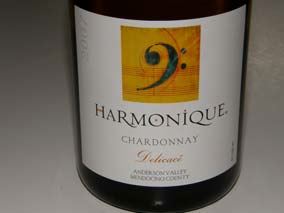 2007 Harmonique Delicacé Anderson Valley Chardonnay 13.9% alc., 98 cases, $59. Grapes sourced from the 24-year-old vines at Conzelman Vineyard. Clone is believed to be Wente. Yields less than 1.5 tons per acre. Whole cluster pressed, fermented in a combination of new French oak, neutral oak and stainless steel barrels. After blending of separate lots, the wine was aged for 8 months, and then bottle aged for an additional 4 months before release. · Straw colored. Aromas of citrus, banana and oak toast. Subdued but pleasing white stone fruit flavors with a sidecar of caramel from oak. More richness and fullness on the palate than the un-oaked version but not overblown. I mixed this Chardonnay with the Harmonique un-oaked version and felt this produced an even more complete Chardonnay.
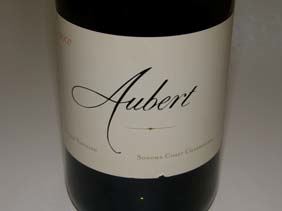 2007 Aubert Ritchie Vineyard Sonoma Coast Chardonnay 15.1% alc., $80. · Deep golden yellow color. Nose of pears, apples, butterscotch and the faintest toasted oak. Rich and generously flavored, featuring pears, white peaches and toasty oak. A big, in your face wine with a hint of heat on the finish. The texture is pure cream and the lively grip of acidity plays off the fruit nicely. A full-throttle Chardonnay that is very alluring. I must admit a weakness for this type of Chardonnay.
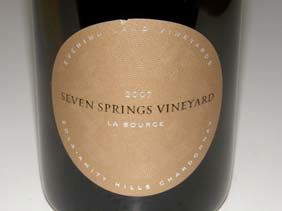 2007 Evening Lands Vineyards Seven Springs Vineyard La Source Eola- Amity Hills Chardonnay 12.9% alc., $80. · Light gold color. Delicate aromas of pear, banana and a hint of oak which are echoed on the palate. Soft and velvety in the mouth with ample acidity. A white Burgundy styled wine that is reserved, yet quite enjoyable. One of the best Chardonnays I have sampled from Oregon.
2007 Aubert Lauren Sonoma Coast Chardonnay 15.8% alc., $90. · A sipping Chardonnay featuring a rich and full-bodied palate of butterscotch, butter, light caramel, smoke and toasty oak. Full-bodied and creamy with a big, lengthy finish that is slightly hot. Fun to contemplate but two glasses max!
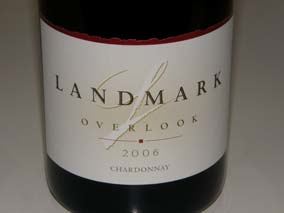 2006 Landmark Overlook Chardonnay 14.4% alc., $21. 77% Sonoma County, 14% Santa Barbara County, and 9% Monterey County. · Yellow gold color. Pleasing aromas of pears, apples, butter, and toasty oak. Moderately rich core of yellow fruits including pears, apples and banana with a snappy and cleansing finish. One of the most consistently reliable producers of Chardonnay in California.
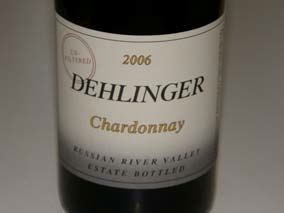 2006 Dehlinger Russian River Valley Chardonnay 14.5% alc., $33. · Pale yellow with the slightest haze (unfiltered). Demure perfume of honeysuckle, lemon zest and riverbed. Discreetly rich flavors of white peaches, roasted nuts, and oak spice with a mineral underpinning. An elegantly and restrained wine that is charming and stylish. Dehlinger has quietly crafted one of California’s best Chardonnays for many years.
2006 Windy Oaks Estate One Acre Estate Santa Cruz Mountains Chardonnay 13.9% alc., $38. Barrel fermented, aged a minimum of 15 months. Unfined and unfiltered. · Golden yellow, slightly hazy color. Alluring aromas of butter, grapefruit and beeswax. Penetrating flavors of white stone fruits with an echo of oak. The viscous mouth feel is very appealing and the aromatic finish is fruity and lengthy.
2006 Radio-Coteau Savoy Vineyard Anderson Valley Chardonnay 14.2% alc., 454 cases, $45. · Unfiltered. A delicious wine filled with a rich presence of apples, white peaches, brioche and toasty oak. Harmonious in every way with a finish that would make Hollywood envious. Great with Caesar salad.
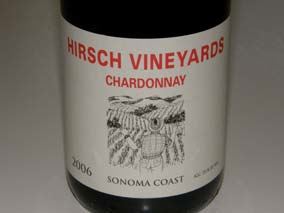 2006 Hirsch Vineyard Sonoma Coast Chardonnay 15.1% alc., $50. The first Chardonnay release from Hirsch fruit that formerly was vinified by winery clients. · Intriguing aromas of green apples, wet stones and smoke. Tangy apple flavors with oak playing a supporting role. Hi-tone acidity and remarkable minerality. Really good.
2006 L’Angevin Charles Heintz Vineyard Sonoma Coast Chardonnay 14.2% alc., $55. I have sampled this wine on several occasions with consistent results. I am addicted to this wine. · Alive with the scent and flavor of baking spice including cinnamon. A lush middle palate features multilayered tastes of apple tart, poached pears, and fresh lemon curd. The fruit is pulled into line with fine acidity and the mouth feel is soft and creamy. Perfectly composed and special in every way.
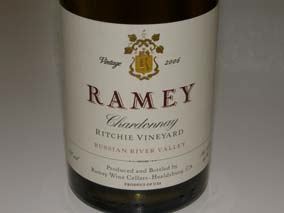 2006 Ramey Ritchie Vineyard Russian River Valley Chardonnay 14.5% alc., $63. · Demure apple and aromas which emerge with swirling. Very, very tasty apple tart flavor with the faintest note of savory spices and oak. Finishes with a tangy acidic edge. Sampled side-by-side with Aubert Ritchie Vineyard. Not as showy and in your face as the Aubert bottling, but very charming. A debutante compared to a hooker.
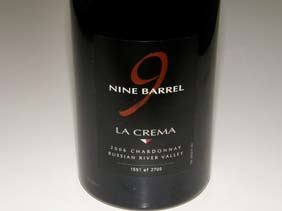 2006 La Crema Nine Barrel Russian River Valley Chardonnay 14,5% alc., 225 cases, $70. Nine best barrels in the cellar. · Very fruity nose with an array of interesting aromas including roasted pear, tutti-fruity, vanilla and toasted meringue. Full-bodied poached pear and apple tart flavors cascade through the palate. A hedonistic wine for contemplation.
2005 Sonoma Coast Vineyards Sonoma Coast Chardonnay 14.2% alc., 395 cases, $45. Sourced from Petersen and Hawk Hill Vineyards. Dijon 95 and Wente clones. Ages sur lees for 11 months using 50% new Sirugue French oak. · Very Burgundian in style featuring flavors of apple, citrus, brioche and roasted nuts with enough bright and crisp acidity to cut through lobster and an underlying minerality that is startling for California. Simply great.
2005 Kistler Durell Vineyard Sonoma Coast Chardonnay 14.1% alc., 1,930 cases, $70. · Deep yellow with a hint of orange. Aromas of poached apple, herbal oak and oak char. Tasty cooked white fruits with butter and oak highlights. Charred oak runs throughout in the background. I prefer Kistler Chardonnays when they are young.
Small Sips of Pinot2007 Aquinas Napa Valley Pinot Noir 13.5% alc., pH 3.52, 24,000 cases, $15, released October 2008. This wine is named for St. Thomas Aquinas who was a 13th century scholar who used the laws of science to support his belief in the existence of the Almighty. · Moderately deep ruby color. Burnt match and oak char on the nose. The juicy dark fruits play second fiddle to the woody vein that runs through to the finish. Softly textured with mild dry tannins. I have admired the value-priced Pinot Noirs from Don Sebastiani & Sons, but this one is not my cup of tea.
2007 Lafond Sta. Rita Hills Pinot Noir 14.5% alc., 2,800 cases, $20. · Deep, dark reddish-purple color. Attractive purity of black cherry fruit on the nose with a hint of smoke. Moderately rich and fruit driven with flavors of black cherries and plum and an edge of oak. Silky textured with soft tannins and a little heat on the finish. Loses appeal in the glass over time.
2007 Trinitas Cellars Carneros Pinot Noir 15.5% alc., $27. Trinitas is the Latin word for Trinity, the fundamental principal of Christianity. Proprietors are Tim and Steph Busch. · Deep reddish-purple color. Aromas of confected berries and smoky oak. Muscular, Syrah-like wine spotlighting pie-filling plum, raspberry and black cherry flavors with gripping tannins and plenty of smoky oak. Everything about this wine is big.
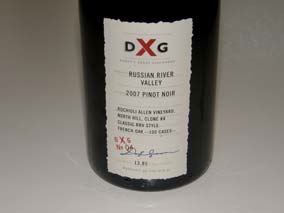 2007 DXG (Daryl’s Great Discovery) Russian River Valley Pinot Noir 13.85% alc., 100 cases, $36. Sourced from the Rochioli Allen Vineyard, North Hill, Pommard 4 clone. Label reads, “DXG represents small lots of high-quality wine ‘finds’ to share with wine lovers.” Daryl Groom is winemaker. Piaceri Wines. Redder-toned color. All oak char and tobacco on the nose. Tasty and vivid Bing · Redder-toned color. All oak char and tobacco on the nose. Tasty and vivid Bing cherries on the palate with a hint of mocha and some oak char in the background. Soft in the mouth with an elegant bent.
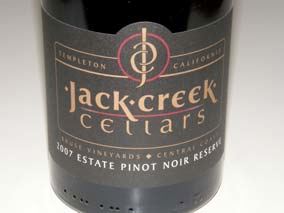 2007 Jack Creek Cellars Kruse Vineyards Estate Reserve Central Coast Pinot Noir 14.6% alc., $42. The Kruse Vineyard is located at the South end of the Santa Lucia Highlands Mountain range in Templeton. · The big nose features black fruits, spice, white pepper, wood box and a hint of alcohol. Beefy core of blackberry, raspberry and bruised plum fruit with oak in the background. Very big and Caliesque. Heavy-handed with a jolt of tannin and alcohol.
2007 Foxen Julia’s Vineyard Santa Maria Valley Pinot Noir 15.2% alc., $45. Unfined, unfiltered. · Deep color. Oak char and ash dominate the aromas. Impenetrable prodigious black fruits with a vein of citrus in the background and flamboyant dry tannins on the finish. This wine will need another 2 to 3 years at least to emerge, but will always be a big wine.
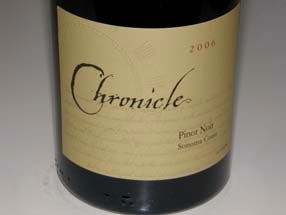 2006 Chronicle Sonoma Coast Pinot Noir 14.0% alc., $35. Vinified by noted winemaker Ted Lemon (Littorai). · Plenty of strawberries on the nose with hints of balsa wood and oak. Pleasing berry and red current flavors with a touch of herbal oak on the dry finish. Soft and elegant with supple tannins. Lacks nuance and nothing really stands out.
2005 Capiaux Cellars Chimera Sonoma County Pinot Noir 14.4% alc., $29. · Black grapes, wood shed, char and plenty of oak on the nose. Monolithic dark fruits with a sidecar of seasoned oak. Lacks nuance.
2005 Capiaux Cellars Widdoes Vineyard Russian River Valley Pinot Noir 14.1% alc., $37. · Slightly porto aromas overshadow pleasing scents of berry jam, spiced plum and fresh-baked cookies. Overripe flavors of currents, raisins and cola with prominent toasted oak. Decent acidity but it can’t match up with the aggressive tannins.
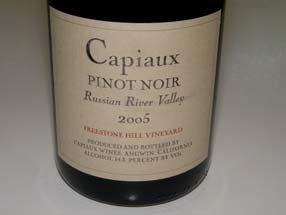 2005 Capiaux Cellars Freestone Hill Vineyard Sonoma Coast Pinot Noir 14.3% alc., $40. · Interesting aromas that change in the glass consisting of fresh berries, forest floor, pine, smoke and mint. Juicy black cherry and dark red berry core with finegrained tannins. The oak is reigned in nicely. The lightest weighted of the 2005 Capiaux wines tasted and my favorite.
2005 Capiaux Cellars Garys‘ Vineyard Santa Lucia Highlands Pinot Noir 14.6% alc., $52. · Lovely aromas of ripe, dark cherries and strawberries. Full-bodied and a bit rustic with very ripe dark fruit flavors of berries, root beer and brown spice. A solid fruit core but a touch too ripe for my taste. Balance is spot on.
Pinot BriefsEarly Reports on 2009 Burgundy Glowing There is a Burgundy legend that vintages that end in 9 are great vintages and looks like 2009 is following history. The weather in 2009 has been exceptional with a mild spring and a warm, dry summer. Some are comparing 2009 to the magnificent 2005 vintage.No Consensus Among Wine Competitions in U.S. A paper was recently published in the Journal of Wine Economics (Volume 4, Issue 1, Spring, 2009) titled, “An Analysis of the Concordance Among 13 U.S. Wine Competitions.” The author of the study, Robert T. Hodgson, analyzed over 4,000 wines entered in 13 U.S. wine competitions and found little concordance among the venues awarding Gold medals. Many wines that are viewed as extraordinarily good at some competitions and awarded a Gold medal, are viewed as below average at others and receive no award. Winning a Gold medal is greatly influenced by chance alone. I believe the discrepancy among different competitions depends on a number of factors including the difference in makeup and qualifications of the judging panel, the breadth of wines submitted for judging, and the amount of wines required to be tasted by judges daily. I personally, rarely participate in judging panels, finding that the subjectivity of wine judging is so broad that consensus is almost never the rule. Minerality in Wine Wes Hagen, winegrower and winemaker at Clos Pepe Vineyard in the Sta. Rita Hllls, explains the source of minerality in wines on this short video titled, “How does wine get earthy?” http://askawinemaker.blogspot.com/2009/07/how-does-terroir-make-it-into-glass-of.html. Hagen believes that grape skin thickness is influenced by calcium and silica which are absorbed from the soil and thicken the skins, contributing to minerality. Also, minerality is more evident in wines with high acidity or low pH. Scientists Decoding Brettanomyces DNA Brettanomyces or brett for short, is due to a yeast contamination of wine leading to aromas of sweaty horse, manure, Band-Aid and burnt plastic. At low levels, it may add interest, body and complexity and appeal to some drinkers, but in significant levels it is considered a serious fault and ruins wine. Because it cannot currently be controlled, it cannot be deliberately introduced during winemaking. Scientists are now attempting to decode and sequence the brettanomyces genome, hoping that this information will lead to prevention of this yeast contamination. In addition, knowledge may be gained that allows control of the yeast so that it may be purposely incorporated into wines. One of Oregon’s Wine Industry Founders Dies Richard Sommer was something of a recluse so his story is not widely known. Sommer came from California to introduce vitis vinifera grapes to Oregon’s Umpqua Valley in 1961. He was very well educated in plant ecology, having attended University California Davis and University California Berkeley. He planted the first vinifera vines in Oregon since Repeal on a turkey farm west of Roseburg. He eventually established Hillcrest Vineyards and today it is the state’s oldest continuously running vinifera winery. Pinot Noir Event in South Africa Sommelier Jörg Pfützner is hosting “Investigating Pinot Noir” at Creation Wines on September 19, 2009 in the Hemel-en-Aarde near Walker Bay in the Western Cape. The tasting will compare the maritime Hemel-en-Aarde region of South Africa with other cool climate Pinot Noirs of New Zealand and Burgundy. This event is South Africa’s largest comparative tasting of Pinot Noir and is supported by the Hemel-en-Aarde Wine Growers Association to raise awareness of the cool climate Pinot Noirs of South Africa. For more information visit www.blog.sigihiss.com/?p=1836. California Wineries Exceed 2,800 The Wine Institute reports that there are over 2,800 wineries in California with wine grapes now being grown in 48 of the state’s 58 counties. California is the fourth largest producer of wine in the world, after Italy, France and Spain. California New Plantings of Pinot Noir According to Wines & Vines (July 2, 2009), Nat Di Buduo of Allied Grape Growers spoke at a recent Vineyard Valuation and Ag Symposium in Lodi, and reported that 36% of new plantings in California are Pinot Noir, significantly ahead of Chardonnay (22%) and Pinot Gris (16%). He felt that Pinot Noir and Pinot Gris were being over-planted.
What This Country Needs is a Good $8 Pinot Noir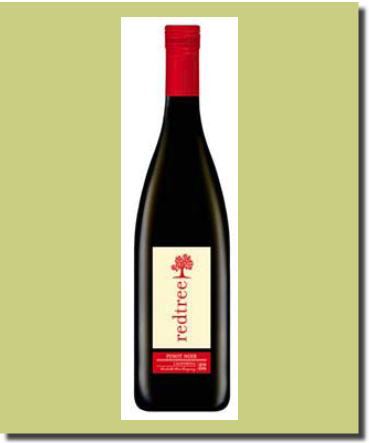 At a time when young consumers are looking for a good Pinot Noir they can afford, along comes the 2008 Redtree Pinot Noir from Cecchetti Wine Company. Everything is appealing about this wine. The label is classy, the red screw cap is eye-catching, the alcohol is low at 12.5%, and the wine inside is remarkably good for the price. In some markets this wine has been discounted to less than $6. The wine includes some red varieties other than Pinot Noir and is made with oak chips instead of oak barrels. Cecchetti Wine Company is a new face in the wine business, having been launched by industry veteran Roy Cecchetti and his wife Rachael in 2007. Roy Cecchetti has over 20 years of experience developing wine brands, including the successful Pepperwood Grove. The former winemaker for Pepperwood Grove, Bob Broman, has been enlisted as winemaker. Cecchetti Wine Company has two labels: Line 39 includes Petite Sirah, Cabernet Sauvignon and Sauvignon Blanc from the Lake County AVA. The Redtree label offers several varietals for early consumption at affordable prices.
2008 Redtree California Pinot Noir 12.5% alc., pH 3.54, 5,416 cases, $8, released February 2009, screw cap. · Very attractive aromas of strawberries, cherries, red licorice, forest floor, mushrooms and smoky oak. A lighter-weighted offering that is demurely flavored with red cherries, raspberries and strawberries with a hint of oak and sandalwood in the background. The tannins are supple and a spark of acidity marks the short finish. I would recommend chilling this wine slightly before serving. Very good for the money and the best California Pinot Noir I have ever tasted at this price point.
Redtree Pinot Noir is widely distributed. For more information, visit the website at www.cecchettiwineco.com. |